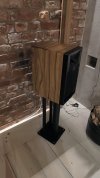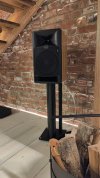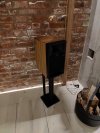Yes, you put the BR port area and woofer Sd (logarithmically) in relation to each other and thus correct the different levels. But since Amir does not make "real" nearfield measurements anyway (the mic distance is too large for that), the measurements are only guidelines.
Amir always performs the measurements the same way, different speakers can be compared as long as the ratio of BR port area to woofer Sd is roughly comparable.
What you should pay attention to is the sound pressure level distance of the intended Helmholtz resonance (BR port tuning) and the resonances with the highest sound level and if the baffle step correction is included or not.
Here is the BR-port near-field measurement of a 2-way bookshelf speaker with 8'' woofer. In yellow is the frequency response without baffle step correction (BSC), in green with.
View attachment 253841
I didn't bother to damp and optimize the resonances of the BR-Port (simply a pipe without optimization). Since Q of the "loudest" resonance is high (the resonance is therefore relatively narrow), the design is just fine (mediocre).
Between the desired Helmholtz resonance and the undesired BR port resonances is about 11dB sound pressure difference without BSC. Good designs achieve considerably more difference (>15dB). This ensures that the BR port resonances hardly play a role in the frequency response of the speaker.
Now take another look at Amir's BR port measurement of the JBL 708i. There, the sound pressure difference without BSC is just about 2-3dB. This is not a good result for a speaker in this price range.
View attachment 253843
It is good that this has been pointed out. We can discuss the audibility or inaudibility for a long time (as for example with HD measurements).
But the fact is that a well-designed speaker in this price range does not have to show such severe BR port resonances (similar to how a certain SINAD is expected with hifi devices from a certain price range onwards).



